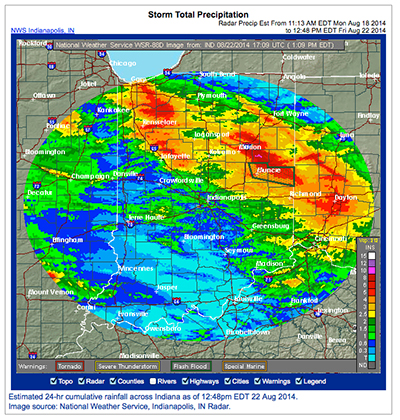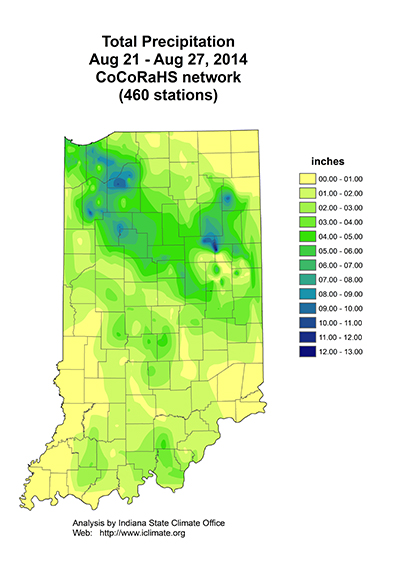USDA-NIFA Extension IPM Grant
Pest & Crop Newsletter, Entomology Extension, Purdue University
- Soybean Vein Necrosis Virus
- VIDEO: Soybean Vein Necrosis Virus North Central Soybean Research Program
Western Bean Cutworm Moth Flight Lower This Year – (John Obermeyer)
Thanks to our network of pheromone trap cooperators throughout the state, we are able to assess the flight of western bean cutworm moths this summer. As you can see from the following graph, this year’s numbers have been much lower, though the peak period of mid-July remained. Certainly the accompanying good news is that larval damage reports have essentially been zilch.
It is now up to speculation to attribute these lower numbers. The list of possibilities includes the polar vortex winter causing high mortality in overwintering pre-pupa larva, a higher percentage of trait-targeted corn being grown in Indiana’s high-risk areas, and/or natural enemies (e.g., predators, parasites) have caught up with them since their known presence in 2006.
Hopefully we can convince the trappers to again monitor for this pest next season, to determine if this decline is a trend or is a one-year blip on the curve.
Total WBC Moth Captures By Week
![]()
Click here to see the 2014 Corn Earworm Trap Report
![]()
Soybean Vein Necrosis Virus – (Kiersten Wise, Daren Mueller, Iowa State, and Damon Smith, Wisconsin) -
Soybean Vein Necrosis Virus (SVNV) causes a virus disease in soybean that has been observed across the North Central U.S. in the last few years. The following video describes how to accurately diagnosis SVNV and distinguish this disease from other common soybean diseases.
Symptoms caused by this virus include light green patches or mottled green and brown speckled areas associated with veins. As symptoms progress, affected leaf tissue may die, and leaves will appear scorched.
SVNV is a virus that is vectored by tiny, winged insects called thrips. Thrips do not commonly cause economic damage to soybeans in the Midwest. Although farmers may be tempted to apply an insecticide to reduce thrips populations “just in case,” at this point in time we do not recommend insecticide applications in response to detection of SVNV since we don’t know what, if any, effect disease may have on yield. For now, we will continue to keep an eye on this disease, and assess its potential impact so that we can make more informed future management recommendations.
![]()
Flood or Ponding Damage to Corn Late in the Growing Season – (Bob Nielsen) -
Excessive rainfall events (e.g., “goose-drownders”) that occur late in the growing season can cause flooding of rivers, creeks, and streams as well as ponded areas within fields distant from floodwaters. The consequences to grain yield and quality from the damage caused by such flooding/ponding are difficult to pinpoint with much accuracy because little research exists that addresses these chance-occurring yield-limiting factors. Risks and expectations, however, can be outlined.
Crops inundated by standing water at this time of the year typically do not survive as long as those similarly affected earlier in the season due to the warmer air and soil temperatures. Oxygen deprivation in saturated soils quickly causes significant deterioration and death of above- and below-ground plant tissue. Affected crops may only survive a few days with typical August temperatures.
Further physical crop damage (soil erosion, washing away of plants, lodging of plants, and plant tissue damage) occurs from the force of the flowing water on land adjacent to flooded creeks and rivers as well as from any debris caught up in the floodwaters.
Deposits of sediment and crop residues that remain on crop plants once the water recedes can either outright smother any surviving plants or greatly reduce their ability to capture sunlight and photosynthesize carbohydrates.
Mud and crud that cakes the leaves and stalks encourage subsequent development of fungal and bacterial diseases in damaged plant tissue. In particular, bacterial ear rot often develops when flood waters rise up to or above the developing ears of corn plants (Nielsen, 2003a; Nielsen & Ruhl, 1998).
Crops that technically survive less severe bouts of ponding and saturated soils nevertheless suffer significant damage to their root systems. The immediate effects will be stunting of plant development. In the longer term, root systems compromised by ponding and saturated soils today will be less able to sustain the crops during the remainder of the grain filling period. The effects of such compromised root systems will be more dramatic if hot and dry conditions prevail over coming weeks.
For corn, damage to its root system today will predispose the crop to the development of root and stalk rots later by virtue of the photosynthetic stress imposed by the limited root system during the important grain filling period following pollination. Corn often responds to severe shortages of photosynthate by remobilizing stored carbohydrates from the lower stalk tissues to the developing grain. Not only does such remobilization weaken the lower stalk tissue, but it also increases the vulnerability of those “cannibalized” tissues to infection by root- and stalk-rotting fungal organisims. Monitor affected fields later in August and early September for the possible development of stalk rots and modify harvest-timing strategies accordingly.
Loss of soil nitrate nitrogen in saturated soils due to denitrification or leaching processes
can be at least five percent per day given the current warm soil temperatures (Hoeft, 2002). Effects of such nitrogen loss on crops this late in the growing season are difficult to estimate, but, coupled with significant root damage by saturated soils, will contribute to increased stress in corn during the remainder of the grain filling period.
Assessing the effects of hail damage to corn can be challenging. Important factors include the amount of defoliation and stalk bruising caused by the hail stones relative to the growth stage of the crop. While hail damage can result in severe yield losses in corn, most of the time the human eye perceives greater damage than truly exists. Browse the two references listed below (Nielsen, 2001; Vorst, 1993) on hail damage assessment for more information.
Wind damage to corn occurs either as stalk breakage (aka “green snap”) or root lodging (plants uprooted and laying nearly flat to the ground). The yield effect of “green snap” damage depends on the percentage of field affected and whether the stalk breakage occurs above or below the ear, but is usually serious regardless. Obviously, stalk breakage below the ear results in zero yield for that plant. Stalk breakage above the ear results in significant yield loss due to the loss of upper canopy photosynthesis capacity for that plant. Root lodged corn will recover or straighten up to varying degrees depending on the growth stage of the crop. Generally, younger corn has a greater ability to straighten up with minimal “goose-necking” than older corn. Yield effects of root lodging depend on whether soil moisture remains adequate for root regeneration, the severity of root damage due to the uprooting nature of root lodging, and the degree of “goose-necking” that develops and its effect on the harvestability of the crop.
Key Source of Information
Purdue Univ. 2009. Crop Management Information for Flood-Damaged Field Crops. A feature of KingCorn.org, Purdue University. [online] <http://www.kingcorn.org/cafe/flood> [URL accessed Aug 2014].
Related References
Hoeft, Robert. 2002. Predicting/Measuring Nitrogen Loss. Univ. of Illinois Pest & Crop Bulletin (5/17/02). [online] <http://bulletin.ipm.illinois.edu/pastpest/articles/200208n.html> [URL accessed Aug 2014].
Nielsen, Bob. 2012. Recovery From Hail Damage to Young Corn. .Corny News Network, Purdue Univ. [online] <http://www.kingcorn.org/news/timeless/HailDamageYoungCorn.html> [URL accessed Aug 2014].
Nielsen, R.L. (Bob). 2003a. Bacterial Ear Rot in Corn Due to Flooding. Corny News Network, Purdue Univ. [online] <http://www.kingcorn.org/news/articles.03/EarRot-0720.html>. [URL accessed Aug 2014].
Nielsen, R.L. (Bob). 2003b. Corn & Soybean Loss From Floods & Ponding. Corny News Network, Purdue Univ. [online] <http://www.kingcorn.org/news/articles.03/Flooding-0717.html>. [URL accessed Aug 2014].
Nielsen, RL (Bob) and Gail Ruhl. 1998. Bacterial Ear Rot in Flooded Corn. Corny News Network, Purdue Univ. [online] <http://www.kingcorn.org/news/articles.98/p&c9828.html>. [URL accessed Aug 2014].
Roth, Greg and others. [date not avail.] Managing Flood Damaged Crops. Penn. State Univ. [online] <http://goo.gl/7WP4rG> [URL accessed Aug 2014].
Thomison, Peter, Pierce Paul, and Dennis Mills. 2007. Late Season Flood Damage to Corn: Management Considerations. C.O.R.N. Newsletter, Ohio State Univ. [online] <http://agcrops.osu.edu/corn/newsletters/2007/article?issueid=200&articleid=1224> [URL accessed Aug 2014].
Vorst, Jim. 1993. Assessing Hail Damage to Corn. Purdue Univ. Extension Publication NCH-1. [online] <http://www.agcom.purdue.edu/AgCom/Pubs/NCH/NCH-1.html> [URL accessed Aug 2014].
![]()
WEBINAR: Stored Grain Integrated Pest Management in the North Central United States – (NCIPM Center) -
A webinar on Stored Grain Integrated Pest Management in the North Central United States will be held on September 12, 2014 from 10 AM – 12 PM CT and will include:
• Biology and identification of key stored grain pests; basic of IPM for stored grain; proper fumigation issues and challenges - Tom Phillips, Professor of Entomology, Kansas State University, Manhattan, KS
• Prevention of grain infestation: residual insecticides available and their proper application; strategic use of aeration for grain cooling and pest suppression - Frank Arthur, Research Entomologist, USDA ARS, Manhattan, KS
• IPM for corn and other products in the upper Midwest: issues and challenges with grain drying and cooling; pest management for animal feed, ethanol and value-processed food - Linda Mason, Professor of Entomology, Purdue University, West Lafayette, IN
Webinar participants will see and hear presentations by the three teachers and then have an opportunity for live questions and answers. Instructional materials will be provided via internet links.
Pre-registration is required. Go to <http://www.ncipmc.org/training/> to register. Participation will be limited to the first 200 computers. Hosting of viewing sites locally by Extension, government agencies, and private industry is encouraged.
This webinar will be archived for later viewing if you cannot attend this date and time.
Funding for this webinar is provided by USDA-NIFA through grants to the North Central Integrated Pest Management Center.
![]()





